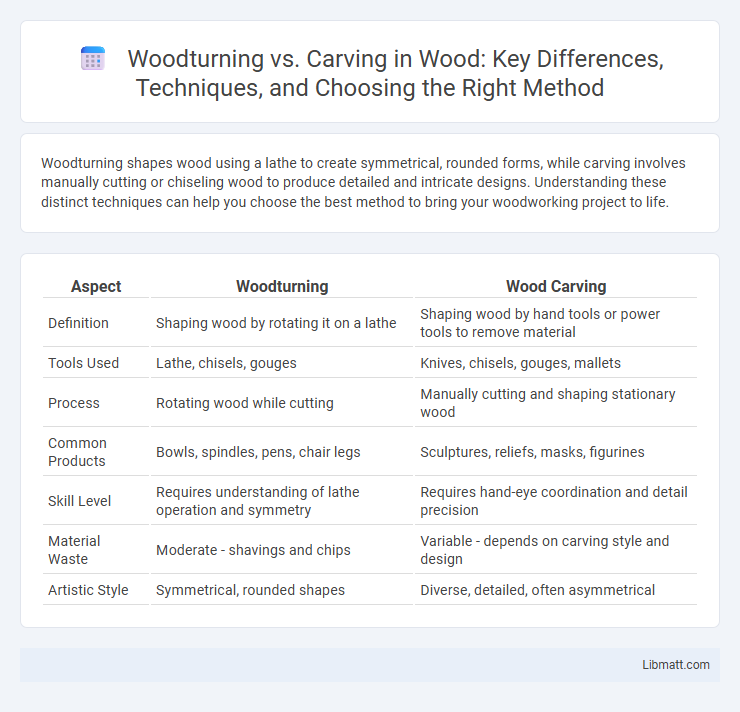Woodturning shapes wood using a lathe to create symmetrical, rounded forms, while carving involves manually cutting or chiseling wood to produce detailed and intricate designs. Understanding these distinct techniques can help you choose the best method to bring your woodworking project to life.
Table of Comparison
| Aspect | Woodturning | Wood Carving |
|---|---|---|
| Definition | Shaping wood by rotating it on a lathe | Shaping wood by hand tools or power tools to remove material |
| Tools Used | Lathe, chisels, gouges | Knives, chisels, gouges, mallets |
| Process | Rotating wood while cutting | Manually cutting and shaping stationary wood |
| Common Products | Bowls, spindles, pens, chair legs | Sculptures, reliefs, masks, figurines |
| Skill Level | Requires understanding of lathe operation and symmetry | Requires hand-eye coordination and detail precision |
| Material Waste | Moderate - shavings and chips | Variable - depends on carving style and design |
| Artistic Style | Symmetrical, rounded shapes | Diverse, detailed, often asymmetrical |
Introduction to Woodturning and Carving
Woodturning is a woodworking technique where a lathe spins the wood while tools shape it into symmetrical forms like bowls or spindles. Carving involves manually removing wood with chisels or knives to create intricate, detailed designs and sculptures. Both methods require skill and precision but differ in tools, techniques, and typical outcomes, with woodturning emphasizing rounded shapes and carving focusing on detailed surface textures.
Defining Woodturning: Techniques and Tools
Woodturning involves shaping wood on a lathe, where the piece rotates against stationary cutting tools such as gouges and chisels, allowing symmetrical designs like bowls and spindles. Techniques include roughing, shaping, and finishing cuts, emphasizing precision and smooth contours. Essential tools for woodturning include the lathe, various specialized turning chisels, sharpening equipment, and safety gear.
Understanding Wood Carving: Methods and Approaches
Wood carving involves shaping wood using tools such as chisels, gouges, and knives to create detailed designs and sculptures, emphasizing precision and intricate textures. Techniques vary from relief carving, which produces images on a flat surface, to chip carving and whittling, allowing artists to achieve diverse artistic effects. Mastery of wood grain properties and tool control is essential for producing smooth curves and sharp edges, distinguishing wood carving from the rotational shaping of woodturning.
Key Differences Between Woodturning and Carving
Woodturning involves shaping wood on a lathe, producing symmetrical and rounded designs, while carving requires hand tools to sculpt detailed, intricate patterns directly on the wood surface. Woodturning typically creates items like bowls, spindles, and pens, emphasizing rotational symmetry, whereas carving focuses on reliefs, figures, and textured surfaces with asymmetrical or organic forms. The primary difference lies in the process: woodturning is a subtractive method using rotational force, whereas carving is a direct manual shaping technique without mechanical rotation.
Skill Levels Required for Woodturning vs Carving
Woodturning generally requires mastering the use of a lathe and understanding wood types, demanding steady hand-eye coordination and precision for shaping symmetrical pieces. Carving involves intricate detail work and can range from basic cuts to complex designs, often necessitating a higher level of manual dexterity and artistic skill. Your skill level in either craft will evolve with practice, but woodturning tends to have a more structured learning curve while carving offers more flexibility for beginner to advanced techniques.
Types of Projects: What You Can Create
Woodturning enables the creation of symmetrical, rounded objects such as bowls, spindles, and pens through a rotating lathe. Carving offers intricate detail work suited for decorative panels, figurines, and relief sculptures by removing wood with chisels and knives. Both techniques allow artisans to produce unique, handcrafted wooden items, with woodturning favoring functional shapes and carving excelling in elaborate, artistic designs.
Essential Tools and Equipment Compared
Woodturning requires a lathe, turning chisels, gouges, and faceplates essential for rotating and shaping wood. Carving depends on hand tools such as knives, chisels, gouges, and mallets for detailed, direct wood removal. Both crafts benefit from sharpening stones and safety gear, but their toolsets are distinct due to different techniques and precision requirements.
Choosing the Right Method for Your Project
Choosing the right method for your project depends largely on your end goal and the type of wood you are working with. Woodturning excels at creating symmetrical, rounded objects like bowls, spindles, and pens, using a lathe for precise shaping, while carving allows for detailed, intricate designs and personal artistic expression on various wood types. Assessing your skill level, desired texture, and the complexity of your design will help you determine whether woodturning or carving best suits your creative vision and project requirements.
Safety Considerations in Woodturning and Carving
Woodturning requires stringent safety measures such as using face shields, securing loose clothing, and maintaining sharp tools to prevent flying debris and accidents. Carving demands careful handling of sharp knives and gouges with protective gloves and controlled cutting motions to avoid slips and cuts. Both crafts emphasize proper workspace lighting and stable work surfaces to enhance precision and reduce injury risks.
Conclusion: Which Craft Suits You Best?
Woodturning offers a faster production of symmetrical, rounded objects using a lathe, ideal for creating bowls, spindles, and decorative vessels, while carving emphasizes intricate, detailed work with hand tools, perfect for personalized sculptures and reliefs. Your choice depends on whether you prefer the mechanical precision and speed of woodturning or the tactile, artistic expression of carving. Assess your interests, patience for tool mastery, and desired project types to determine which craft suits you best.
Woodturning vs carving Infographic

 libmatt.com
libmatt.com